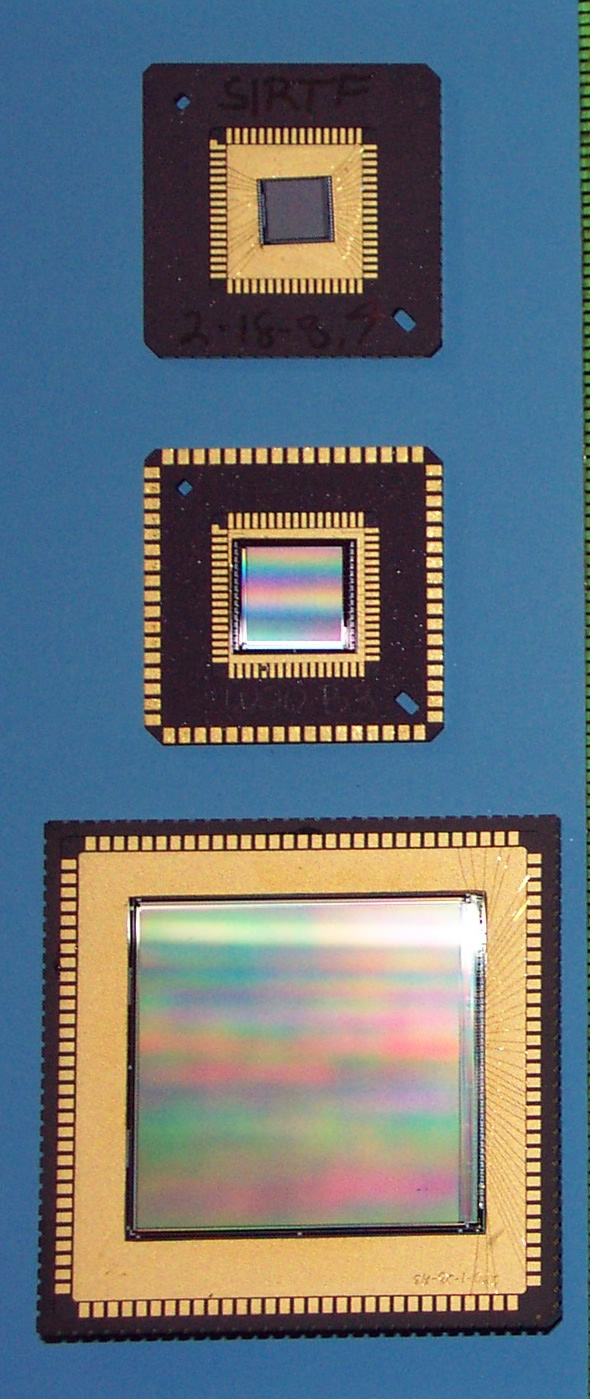

The lectures take place in room HL 414 in the Huygens building, on Thursdays from 13:45 - 15:30 hr (unless otherwise noted - see schedule below).
The lecturer of 'Part A' is Prof. Dr. Bernhard Brandl, office: #535 (Oort building), phone (071) 527-5830, email.
'Part B' will be taught by a number of expert guest lecturers (see below).
The teaching assistant is Michael Wilby, office: #570, email.
Course level is 500. The course language is English.
Detectors are the crucial link between the astronomical target and the observer. As astronomers are aiming at fainter and fainter objects the quality and calibration of the detector systems have become increasingly important. The main goal of this course is to provide an overview of the various physical principles and techniques to detect electromagnetic radiation, from the UV to the sub-millimeter.
The course is split in two parts:
'Part A' (3 ECTS) is aimed at the observational astronomer and provides an overview of common detector technologies and their operation. Course topics are intrinsic and extrinsic photo-conductors, photodiodes and other junction-based detectors, detector arrays, bolometers, coherent receivers, and submillimeter- and millimeterwave heterodyne receivers. The course will not only provide the physical background of the various detector technologies but also cover practical aspects, which are of general interest to the observer, such as cosmetic quality and detector artifacts, linearity and dynamical range, spectral response and bandwidth, quantum efficiency and noise.
'Part B' (3 ECTS) can be followed by all astronomy MSc students, but is mainly aimed at students of 'Astronomy & Instrumentation' or physics. It consists of talks on specific topics, given by renowned guest lecturers.
Students may follow 'Part A' only, but students who want to get credits for 'Part B' must have followed 'Part A' before.
'Part A' and 'Part B' count each 3 ECTS (3+3).
The grade for 'Part A' is based to 80% on the written exam and 20% on the mandatory homeworks. The exam is on 13 April, 14:00 - 17:00 hr. It is a written, "closed book" exam. Pocket calculators are required at the exam.
The credits for 'Part B' require the attendance of (most of) the lectures of 'Part B', as well as a written report based on a literature study. The topic of the latter is closely related to one of the guest lectures. The report has to be written within 6 weeks. The reports will not receive a numerical grade but follow the O/V/G scheme for simplicity.
The course will be heavily based on the book Detection of Light - from the Ultraviolet to the Submillimeter, by George Rieke, 2nd Edition, 2003, Cambridge University Press, ISBN 0-521-01710-6. It is recommended that students get their own copy of this book.
Recommended for further reading are:
|
# |
Date |
Title |
Topics |
Homework |
|
1 |
Friday, 3-Feb-17, 09:00 - 10:45 |
Organization & Refresher of Solid State Physics | General: grading, exercises, book, nature of light, EM spectrum, technology, photographic plate, overview of detectors principles and types; solid state physics: atomic energy levels, crystal: bands, conductors and semi-condd., k-vector, Fermi energy |
|
|
2 |
9-Feb-17 |
Intrinsic Photoconductors & Noise | general principle, box diagram, conductivity, mobility, tau, gain, quantum efficiency and responsivity; intro noise: poisson & Gaussian & 1/f noise; detector noise: Johnson, kTC, 1/f, BLIP |
|
3 |
16-Feb-17 |
Extrinsic Photoconductors | energy bands, doping, wavelength ranges, limitations, drawbacks and comparisons; BIB detectors, photodiodes, avalanche diodes |
|
4 |
23-Feb-17 |
IR Arrays & CCDs | IR arrays: principle, construction, readout electronics; CCDs: principle, back/front illuminated, thinned, readout, CTE, CT architectures, variants |
|
5 |
9-Mar-17 |
IR Arrays & CCDs |
|
|
6 |
16-Mar-17 |
Operations and Artifacts | Readout schemes: SUR, Fowler, linearity & dynamic range, data rates; cryogenics |
|
7 |
23-Mar-17 |
Bolometers | Basic operation, time constants, superconducting, edged; comparison: responsivity, noise, NEP |
|
8 |
30-Mar-17 |
Heterodyne Detectors | general principle, IF, mixing, sidebands, bandwidth, components (HEB, SIS); performance: throughput, S/N, noise and antenna temperature, comparison coherent-incoherent detectors |
|
| 13-Apr-17 | 14:00 - 17:00hr | EXAM in room HL414 |
| Date | Speaker | Affiliation | Topic |
| 20-04-17 | Akira Endo | TU Delft | |
| 04-05-17 | Michel Antolovic | TU Delft | |
| 11-05-17 | Marco Beijersbergen | cosine, U Leiden | |
| 18-05-17 | Alessandra Menicucci | TU Delft | |
| 01-06-17 | Derek Ives - cancelled | ESO | |
| 08-06-17 | Jochem Baselmans | SRON/TU Delft | |
| 15-06-17 | Jian-Rong Gao | SRON |
| Lecturer | Project title | Student | Due date |
| Akira Endo | Astronomical Instruments and the Uncertainty Principle | Dilovan Serindag | 6-June-17 |
| Akira Endo | Are Photons invisible? | Eimear O'Reilly | 6-June-17 |
| Michel Antolovic | Photon counting Imaging Systems for Space Applications | Riccardo Baldo | 28-July-17 |
| Michel Antolovic | Electron multiplication in CCDs | Niloofar Khorshid | 10-July-17 |
| Marco Beijersbergen | Detecting X-ray Photons with a DEPFET | Andrew Barr | 27-June-17 |
| Marco Beijersbergen | Detecting Gamma-ray Photons | Dirk van Dam | 28-July-17 |
| Alessandra Menicucci | SPENVIS radiation environment and its effect on detectors: L2 Orbit | John Hefele | 17-July-17 |
| Alessandra Menicucci | SPENVIS radiation environment and its effect on detectors: Highly Elliptical Orbit | Irene Haasnoot | 17-July-17 |
| Jochem Baselmans | MKIDs and LEKIDs | Max Wijsman | 21-July-17 |
| Jochem Baselmans | Designing an on-chip spectrometer | Louis Martin | 21-July-17 |
| J.R. Gao | Should LiteBird use TES or KID detectors? | Dominique Petit | 28-July-17 |
| J.R. Gao | Can you use KIDs for X-ray astronomy? | Hasan Albanna | 28-July-17 |